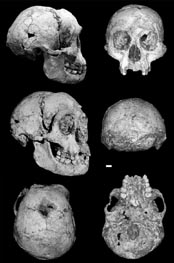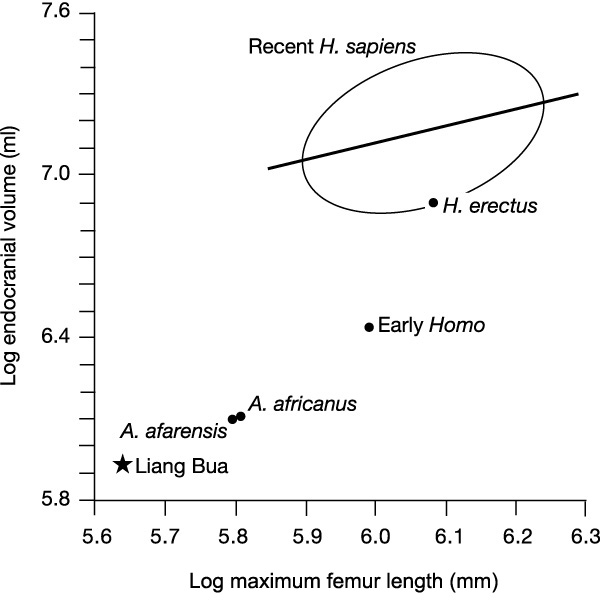October 27, 2004
"Appalling" discovery of hobbitoid hominins
 The internets are buzzing with news about the announcement in Nature (of a discovery back in September 2003) of a new pygmy hominin species named Homo floresiensis, apparently a local island specialization of Homo erectus. These folks lived on the Indonesian island of Flores, happily hunting pygmy elephants and giant rats, until a volcano did them in about 12,000 years ago. The primary papers in Nature are
"A new small-bodied hominin from the Late Pleistocene of Flores, Indonesia", by Peter Brown et al., and
Archaeology and age of a new hominin from Flores in eastern Indonesia, by M. J. Morwood et al. There's also a discussion paper "Human Evolution Writ Small" by Marta Mirazon and Robert Foley, a news piece by Rex Dalton entitled "Little Lady of Flores Forces Rethink of Human Evolution", and an interview with Brown and Morwood. (Some of this stuff will only be accessible if you have a subscription to Nature, alas).
The internets are buzzing with news about the announcement in Nature (of a discovery back in September 2003) of a new pygmy hominin species named Homo floresiensis, apparently a local island specialization of Homo erectus. These folks lived on the Indonesian island of Flores, happily hunting pygmy elephants and giant rats, until a volcano did them in about 12,000 years ago. The primary papers in Nature are
"A new small-bodied hominin from the Late Pleistocene of Flores, Indonesia", by Peter Brown et al., and
Archaeology and age of a new hominin from Flores in eastern Indonesia, by M. J. Morwood et al. There's also a discussion paper "Human Evolution Writ Small" by Marta Mirazon and Robert Foley, a news piece by Rex Dalton entitled "Little Lady of Flores Forces Rethink of Human Evolution", and an interview with Brown and Morwood. (Some of this stuff will only be accessible if you have a subscription to Nature, alas).
An ignorant headline writer at The Scotsman describes the find as a "species of hobbit-sized ancestors", though Peter Brown, who led the analysis team, states quite clearly in the Nature interview that
Although it was a member of our genus, H. floresiensis is unlikely to have contributed to the gene pool of H. sapiens. So for me, its importance is not in the evolutionary story of modern humans, but in how the broad group from which modern humans evolved may have adapted and evolved to different ecosystems.
Other headlines (e.g. in the NYT) use more appropriate words like "cousins" rather than "ancestors".
There are a couple of linguistic hooks. On the substantive question of the new species' linguistic abilities, Nicholas Wade's NYT piece quotes Morwood (indirectly) as arguing for "yes":
If the stone tools were made by the little Floresians, as Dr. Morwood believes, that is striking evidence of their cognitive abilities. Dr. Morwood says they must have hunted cooperatively to bring down the pygmy elephants. To conduct such hunts, and to fabricate such complex stone tools, they almost certainly had some form of language, he said.
But Wade also quotes Robert Foley (co-authored of the discussion article in Nature) expressing skepticism:
This will be a surprising finding, if true, because the little people have brains slightly smaller than a chimpanzee and similar in size to Australopithecenes, the ape-like ancestors of the human line. Dr. Foley said he would not rule out Dr. Morwood's suggestion but noted that chimpanzees hunt cooperatively without using language. Modern humans are known to have reached Australia by at least 40,000 years ago and were probably in the general neighborhood of Flores at the same time, so it is a plausible alternative that they could have been the makers of the stone tools. "I think it's a big jump" to assume the Floresians had language, Dr. Foley said. He also noted the danger of assuming the Floresians behaved like diminutive people when their nature might in fact have been quite different.
Never mind chimpanzees hunting cooperatively, what about wolves?
If there's any information about sphenoidal angles or cerebral asymmetries in the endocasts, or other possible cranial indications of adaptations for speech, I didn't see it. [Update: Brown et al.'s list of characteristics (of skeleton LB1) includes the laconic note "Cranial base flexed", and Mirazón et al. do comment that "Most of LB1's other characteristics, such as the thickness and proportions of the skull, the flexion evident at the skull base, and the shape of the teeth, are derived traits of the genus Homo."] However, as Rex Dalton's news piece in Nature explains
The hominin bones were not fossilized, but in a condition the team described as being like "mashed potatoes", a result of their age and the damp conditions. "The skeleton had the consistency of wet blotting paper, so a less experienced excavator might have trashed the find," says Richard Roberts of the University of Wollongong, Australia.
so maybe such measurements are not possible or at least not believable.
On a less substantive note, NPR has more Q&A, in which Brown is quoted as saying that
It's the most fabulous testimony to the appalling preservation potential of fossils in the geological record, and makes you wonder just how many fossils of other human species, as well as other members of the animal kingdom, lie concealed in some subterranean time capsule, patiently awaiting discovery! [emphasis added]
If the transcript is accurate, this is a very odd use of the word appalling, which for Brown has apparently been bleached of its negative connotations and just means something like "very surprising".
Well, surprising it certainly is, but appalling? I don't think so. Unless this is a covert reference to the "mashed potatoes" or "soggy blotting paper" consistency of the skeletons, which some might consider at least yucky.
[Update: the degree of encephalization (relation of brain size to body size) was surprisingly low for a descendent of H. erectus, as this figure from Brown et al. shows:

The H. floresiensis skeleton (referred to as "Liang Bua" in the figure, after the location where it was found) is more like an australopithecine in this parameter.]
[Update #2: The low degree of encephalization and the relative size of the tools (which were not found in very close association with the H. floresiensis remains) lead some anthropologists (such as Colin Grove, who is quoted in the linked article) to wonder whether the tools may have come from H. sapiens settlers, whether contemporary or later. And more facts and speculations about the discovery can be found here, here, and here here. ]
Posted by Mark Liberman at October 27, 2004 10:10 PM